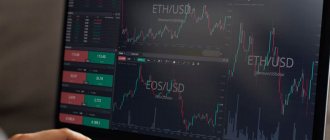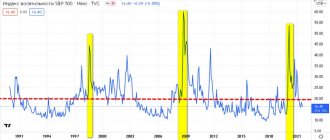Long-term investments are investments with the aim of making a profit, which are made for a long period - from 2 years. Some types of long-term investments involve investments for a period of 5-30 years.
Short-term and medium-term investments differ in that they are aimed at relatively quickly generating profit from an investment project. They can be highly dependent on the current economic situation and do not need long-term planning and development of a serious strategy. Therefore, long-term ones require more responsibility.
Where to invest for the long term? Main areas
An investor can invest funds as follows:
- Investments in company securities;
- Investments in construction, real estate;
- Direct production investments;
- Real investment.
The most complex and profitable option is direct investment.
Sources of long-term investments
We propose to consider the main sources of long-term investments:
- Own funds of the enterprise;
- Net profit, depreciation;
- Loans, bank loans;
- Own funds of private investors;
- Budget resources;
- Investment funds.
Stock
By purchasing a share of a company, an investor receives a share in its authorized capital, essentially becoming its co-owner. If the investment is large enough, you also receive the right to participate in the management of the company and can vote at the shareholders meeting.
Individuals buy securities only through brokers. To do this, you need to open a brokerage account. This can be done online or at the office of the investment company. Before opening an account, we recommend that you carefully select a broker. It is better to trust your money to trusted market participants with a long history. Once you open an account, you will have access to the stock markets and can start trading.
Based on the type of profitability, stocks are usually divided into growth stocks and dividend stocks. In the first case, investors expect a further rise in price of the security. If this happens, then they sell it and make money on the difference between the purchase price and the sale price. In the second case, investors earn money by paying dividends - this is part of the company's profit that is distributed among shareholders. Dividends can be paid once a quarter, once every six months or a year - it all depends on the specific security chosen.
Recommendations
Here are some classic recommendations for a long-term investor:
- Don’t chase quick profits – your money works for the future. Remember that your risk is minimal compared to those who invest for short periods;
- Be careful when using the buy-hold principle. Don't forget about timely portfolio rebalancing;
- invest only the capital that you definitely will not need in the coming years. Never use all your available savings for this - no one is insured against force majeure and unforeseen expenses;
- stick to your chosen strategy. If you have chosen an aggressive strategy, you should spend a little more time analyzing the market. If, upon the occurrence of unfavorable circumstances (for example, a sharp drop in stock prices), you suddenly switch to a conservative strategy and replace shares with OFZs, then there is a high probability of incurring losses;
- if you use borrowed capital, try to keep its share to a minimum. Keep track of the ratio of the cost of loans and the average return on your investments - the latter value should be higher than the first.
Step-by-step investment process
Having decided to choose one of the listed directions, you should prepare well. “Measure twice, cut once” - this rule works perfectly when it comes to investments. A preliminary risk assessment and development of an investment plan will allow the investor to protect himself from failure. To invest more productively, you can divide the process into stages.
- Selection - at the first stage, different investment options are evaluated. It is important to set goals that you plan to achieve. This could be buying a home, a car, going on vacation or other requests. Each goal is tied to the term of the long-term investment. Options suitable for achieving the result are selected.
- Data collection - each investment area identified at the first stage is analyzed. Potential profitability is assessed, risks are identified and compared. Analysis of large projects is carried out by lawyers and financiers. The first will be able to assess the legality of the enterprise and legal risks. Financial specialists will calculate the prospects of the project and economic risks.
- Choice - after a deep analysis of all directions, the most profitable and least dangerous is selected. The selected assets must have a good level of profitability and contribute to achieving the goal. It is important to divide your investments by investing them in different financial assets. Even if one of the projects brings losses, a profitable direction will equalize the situation.
- Investments - when investing money, the main goal is the preservation of capital and its stable growth. Smart investments are made at the most favorable moment, for example, during a crisis situation or a seasonal market decline. Since prices are lower at such times, the investor maximizes profits.
- Monitoring - having made investments, it is important not to forget them and regularly study the market. Each goal should be broken down into intermediate stages, and over time the investment should achieve them. Market behavior can be unpredictable, so if there is no control, capital will burn. An investor should always be aware of the state of his investments in order to exit the project in time or change the amount of participation in it.
Long-term investing involves the investor risking a significant amount. Responsibility for decisions lies solely with the investor, and a competent plan is required from him.
Investments without losses are impossible because investments cannot only bring profit. The skill of an investor lies in the ability to compensate for losses with profits and not lose heart when the investment of funds is unsuccessful.
Types of public investment
The state also often invests its funds in business. All types of public investments are used for the following purposes:
- development of large businesses in the country;
- replenishment of the state budget;
- formation of a positive reputation of the country in the international arena.
The algorithm of actions is simple - the state invests money in industries that are promising for it, they develop. Invested enterprises pay taxes to the state and local budgets. All participants in the process receive their benefits.
Advantages and disadvantages
Long-term investments, like any other instruments, have their pros and cons:
| Advantages | Flaws |
| After a few years, they bring high profits of a constant nature (when investing today, you need to wait for a payback for some time, and then receive net income) | Impossible to get quick income |
| In some cases, savings are repaid repeatedly (during the life of the project you can get extremely large profits several times) | There is a risk of losing all your money. This happens when a startup is poorly managed. The project seems promising, funds are being invested in it, but there is no one to promote it: there is no specialist |
| Cash is constantly in circulation, which means that if events develop successfully, the investor will not be left without profit | There is no liquidity (funds cannot be returned within the investment period). An investor cannot withdraw part of the funds from the project for his own needs, otherwise he will say goodbye to the idea of long-term investments |
| Short-term market fluctuations do not affect long-term investments (today you can lose some money, but after a while you can gain much more). This does not apply to short-term investments, which are highly affected by market volatility |
Efficiency calculations
Calculation of investment efficiency is based on the results of a preliminary audit using financial ratios. Using financial ratios, you can obtain the following data:
- Profitability.
- Liquidity (solvency).
- Asset turnover.
- Market sustainability.
- Financial stability.
- State of fixed assets and their reproduction.
For each type of investment project, specialized long-term investment coverage ratios are selected. True, before using the multiplier, and certainly before making a decision, it is important to determine the net value of the investment project under study in which funds will be invested, or in other words, determine the NPV.
This indicator shows the difference between cash receipts and expenses, adjusted to “today’s time.” In other words, it shows the amount of money that an investor can earn from a project after the cash flows fully recoup its initial costs.
As a rule, if the NVP indicator is greater than zero, then you can invest in the project, but if the indicator is below zero, then it is worth abandoning the investment.
NVP calculation example
The investment amount is 115,000 rubles.
- Investment income for the first year – 32 thousand rubles.
- In the second year - 41 thousand rubles.
- In the third year - 43,750 rubles.
- For the fourth year - 38,250 rubles.
The discount rate is 9.2 percent.
Let's convert future cash flows into current values:
PV1 = 32000 / (1 + 0.092) = 29304.03 rubles.
PV2 = 41000 / (1 + 0.092)2 = 34382.59 rubles.
PV3 = 43750 / (1 + 0.092)3 = 33597.75 rubles.
PV4 = 38250 / (1 + 0.092)4 = 26899.29 rubles.
Net present value = (29304.03 + 34382.59 + 33597.75 + 26899.29) - 11,5000 = 9183.66 rubles.
Result: NPV is equal to 9183.66 rubles.
Precious metals are a very profitable way to invest money. Cash investment in gold can be called a win-win option. Read more about investment instruments.
Read here where to start looking for an investor for your company.
And here https://businessmonster.ru/gde-vzyat-dengi/kredityi/kreditovanie-malogo-biznesa-s-nulya.html you will learn about whether it is worth taking out a loan for a business from scratch if you do not have start-up capital. The nuances of obtaining such a loan.
Results
Financial investments are one of the types of investment. They represent a portfolio of financial assets that help an enterprise increase profitability and improve the efficiency of using available cash. If the definition of financial investments is given at the legislative level, then the enterprise determines the rules for investing in financial instruments for itself.
You can find more complete information on the topic in ConsultantPlus. Free trial access to the system for 2 days.
Long-term investments: how to triple your capital over a 10-year horizon?
It's no secret that stocks always grow well over long horizons. For example, the balanced index of S&P shares gives 9-11% per annum by itself, that is, you can quite easily earn this level of return by investing simply in the index or in a balanced portfolio. Of course, it happens that from time to time stocks go down and can remain in the red for 3 years or even 5 years, but you just need to be ready to “sit out” this fall, not worry or be afraid.
However, there are two “buts” to this strategy. The first is that most of the largest Western investment houses consider the current stock market to be overheated, especially the American one, that is, these 3-5 years of drawdown with a high degree of probability can happen in the near future.
The second “but” is due to the fact that not everyone is satisfied with a yield of 11%. What to do if the profitability level is higher - at the level of 20-30% per annum?
Advertising on Forbes
How do large investment banks or owners of huge fortunes work to achieve this level of profitability? In principle, modern openness and accessibility of information for anyone, including schoolchildren and students, provide their undoubted advantages, which lie in the fact that even a small investor can operate with the same information that large investment houses and managers of billion-dollar fortunes use in order to reach increased level of profitability. The question is about qualifications - does it allow you to work with this information? And is there enough time to do analysis if you have qualifications?
If you are attentive to information flows, there are obvious trends and structural changes in the global economy and the leading economies of the world (where the largest number of issuers are concentrated), taking them into account in your investment portfolio, you can get a very, very good plus to the profitability of a balanced portfolio of shares.
Let's imagine a scale of assets that can provide increased returns on investments, and we will place on this scale only those investment decisions that range from the most obvious to the simply obvious. We will not go beyond this framework - into the area of venture projects, fantasies and assumptions. So, at the very beginning of our scale are the most obvious things. Here we can give two examples, which, of course, are not limited to obvious things.
The first example concerns changes in the structure and amount of military spending of NATO member countries . In connection with the coming to power of President Donald Trump in the United States, we expect structural changes in the economies of the leading countries of the world. The obvious fact is that Trump will force European NATO countries to increase defense spending to 2% of GDP. Of the largest European countries - members of the North Atlantic Alliance, only Great Britain and Poland currently have such a level of spending. Germany, Canada and Spain spend much less - about 1-1.5%. Germany and France alone, which have already pledged to increase defense spending to NATO targets, will account for about 5% of the alliance's defense spending growth, and this will be the strongest driver of revenue growth for European defense companies.
That is, a multibillion-dollar forced change in the structure of the economy is no longer a venture, but an inevitable fact from which a clear European manufacturer and issuer will benefit.
If we talk about the United States, the first draft budget for 2022 suggests an increase in defense spending to $52.3 billion, that is, by 10% (which in absolute numbers is comparable to the Russian defense budget). The largest increase in spending is expected to increase purchases of aircraft, conventional weapons systems (tanks, trucks, etc.), scientific research (R&D) in the field of weapons, maintaining the US nuclear arsenal and cyber security.
That is, billions that were not spent before will now be spent. This means that there will be specific changes in the performance of the relevant companies, in their capitalization and stock market value.
Another example is the upcoming huge increase in spending on civil security due to the increase in various types of threats. The demand for technologies for civil security will grow exponentially in the coming years. The production of new systems for detecting explosives, protecting infrastructure facilities, monitoring public places, drones, robots and artificial intelligence algorithms is coming into play. The technology market for ensuring the security of private property is expected to grow rapidly. The development of semiconductors and the spread of the Internet of Things entail an increasing need for protection against the threat of data leakage. According to a study by consulting firm MarketsandMarkets, the information security market will grow from $70 billion today to $170 billion by 2020.
Further on the asset scale, those with high growth potential should include industries and sectors associated with the technological revolution and the new economy , which will grow by tens and hundreds of percent per year, even if the economy as a whole falls or stagnates. This is absolutely obvious and confirmed by consensus forecasts of authoritative experts. The market for artificial intelligence technologies, according to various estimates, will grow 20 times over the next eight years. Global changes will occur in the production of sensors, microchips, components for the Internet of Things industry, virtual and augmented reality technologies, artificial intelligence, 3D printing, cloud technologies, Big Data, drones and robots for various purposes.
Even further away, in the realm of inevitable explosive growth with little associated risk, are very young industries. On our scale, this is the most interesting segment, since the upside of these assets is very large and is not tens, but hundreds of percent. These assets are like a snowball - they are rapidly increasing in volume, and this movement cannot be stopped. Two different examples can be given here, since a snowball may end up on a clear slope, or it may be on a slope with sparse trees. In the second case, there is a possibility that the snowball will encounter an obstacle and break into pieces, but this is not at all necessary.
An example of a snowball on a clean slope is eSports . Americans already watch eSports events longer than traditional offline games, even when it comes to American football.
Esports is a wildly growing industry that already involves tens, if not hundreds of millions of people who watch online broadcasts without being gamers. This is a global phenomenon that has no borders, and this is its additional potential. Over the past year alone, global eSports revenues have grown by more than 41% to $696 million, and by 2022, according to Newzoo, will grow to almost $1.5 billion. The global eSports audience, according to the same agency, will reach in 2022 385 million people. Today, the largest eSports market is North America, where revenue from eSports projects for the year amounted to $257 million.
Russian capital is already investing in e-sports teams, such examples are known. And it’s clear why. For example, only one of our Russian teams in a single shooting game, which has not yet taken prizes, today has 100,000 fans in the global network, and 20,000 of them are, for some reason, Brazilians. And all this happens online. Global advertising brands have already entered this sector because of the audience. Esports projects have already begun to enter the public market. And the rapid growth of this sector is not an assumption, but an already accomplished fact, which is confirmed by the involvement of hundreds of millions of people.
An example of a snowball on a slope with sparse trees is the cryptocurrency market . Over the past year alone, the capitalization of this market has grown more than 4 times, exceeding a record level of $100 billion in June 2022 after months of growth. This is already a snowball, but how does it differ from the eSports market, which is gaining momentum on the slope without obstacles? Let's ask ourselves a question: could circumstances develop in such a way that my close and distant friends who invest in cryptocurrencies will rush to sell them? The answer is yes, it can easily happen. Can you imagine that my close and distant acquaintances who watch or play eSports will stop doing it? It is unlikely. And this is the difference. A snowball on a clear slope is driven solely by a real need for entertainment, a habit. The second is driven by both real need and speculative excitement, and it is impossible to measure the proportion. It will be possible to understand only when it either crashes against a tree or rolls down safely, becoming huge.
When a phenomenon becomes popular among millions, it inevitably snowballs. The most important thing here is to see this snowball when it is still gaining strength.
Advertising on Forbes
The trends described above should be taken into account by everyone who is thinking about improving the profitability of their investment portfolio and is faced with choosing assets. It is hardly worth going beyond the scale of the most obvious and simply obvious things that we have outlined - into the area of visionary ideas, assumptions and hypotheses. It is much safer for an investor to bet on long-term trends that reflect socio-economic, political and technological changes in society. Investments in such assets will not depend on the daily movements of financial markets, but will bring super-dividends from the inevitable growth of the relevant industries.
Top brokerage companies
Recently, a “backbone” of five largest brokers has formed on the Russian market, which have been at the top for several years.
We are talking about these players:
- Finam;
- BKS;
- Sberbank CIB;
- FC Otkritie;
- VTB Capital.
However, the official methodology for compiling ratings is not the ultimate truth. Therefore, you need to choose a broker based on your personal requirements (licensing, reliability, minimum deposit, available assets, commissions, unique offers, etc.).










